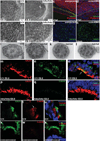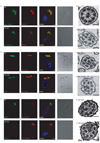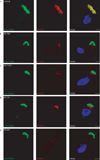The coiled-coil domain containing protein CCDC40 is essential for motile cilia function and left-right axis formation
- PMID: 21131974
- PMCID: PMC3132183
- DOI: 10.1038/ng.727
The coiled-coil domain containing protein CCDC40 is essential for motile cilia function and left-right axis formation
Abstract
Primary ciliary dyskinesia (PCD) is a genetically heterogeneous autosomal recessive disorder characterized by recurrent infections of the respiratory tract associated with the abnormal function of motile cilia. Approximately half of individuals with PCD also have alterations in the left-right organization of their internal organ positioning, including situs inversus and situs ambiguous (Kartagener's syndrome). Here, we identify an uncharacterized coiled-coil domain containing a protein, CCDC40, essential for correct left-right patterning in mouse, zebrafish and human. In mouse and zebrafish, Ccdc40 is expressed in tissues that contain motile cilia, and mutations in Ccdc40 result in cilia with reduced ranges of motility. We further show that CCDC40 mutations in humans result in a variant of PCD characterized by misplacement of the central pair of microtubules and defective assembly of inner dynein arms and dynein regulatory complexes. CCDC40 localizes to motile cilia and the apical cytoplasm and is required for axonemal recruitment of CCDC39, disruption of which underlies a similar variant of PCD.
Figures





Comment in
-
Coiled-coils and motile cilia.Nat Genet. 2011 Jan;43(1):10-1. doi: 10.1038/ng0111-10. Nat Genet. 2011. PMID: 21217638 No abstract available.
References
Publication types
MeSH terms
Substances
Grants and funding
LinkOut - more resources
Full Text Sources
Other Literature Sources
Medical
Molecular Biology Databases

